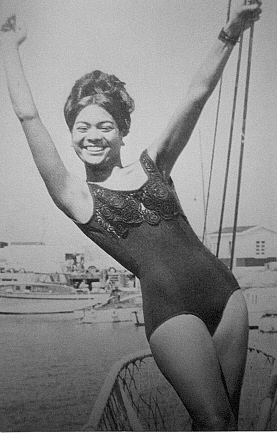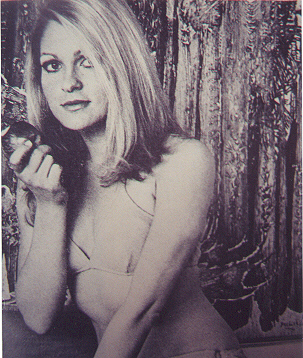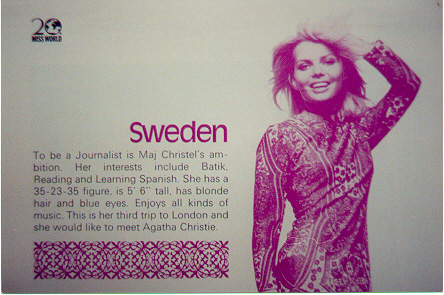 MISS WORLD 1970
MISS WORLD 1970
MASTER CLASS
PART ONE
Presented by
Donald West,
Chair of the Department of
Miss Word Studies
Presented by
 MISS WORLD 1970
MISS WORLD 1970
MASTER CLASS
PART ONE
Donald West,
Chair of the Department of
Miss Word Studies
Good Evening. As the Dean of Beauty School, I want to thank all of you for rearranging your schedules in order to attend this year's Master Class on Miss World 1970. As you know, the enrollment for this Master Class was so overwhelming that our beloved Helen O'Connell auditorium was actually too small to accommodate everyone.
I therefore wish to thank Assistant Dean Harris for making the arrangements for us to hold this class in the Madhu Sapre Track and Field Stadium. This was no small feat on his part, as he had to move the Kristiina Heinmets Ballroom Dancing Championships from this evening to this afternoon. You will of
course understand that the colored boa feathers that are clinging to your seats and shoes is but a small price to pay for tonight's program.
Tonight, we shall turn the clock back to the 1970 Miss World Pageant, a "spicy" event unlike any other. A pageant that faced enormous adversity and grabbed headlines around the world. I do not want to steal Professor West's thunder here by revealing too much, but suffice it to say, you had "better fasten your seat belts, it's going to be a bumpy ride."
Ladies and Gentlemen, we now present our Master Class on Miss World 1970, by esteemed Professer Donald West.
MILITANCY
Julia Morley had much to be pleased about in 1970. The 31-year-old wife of Mecca Ltd. head Eric Morley had taken over as chief organizer director of Mecca's Miss World contest two years earlier. These pageants ran smoothly under her capable hand, and the winners (Australia's Penelope Plummer in 1968 and Austria's Eva Rueber-Staier in 1969) were respected and served their reigns with little or no controversy.
However, as Miss World 1970 contest approached, Julia and the other organizers were concerned about two groups of militants who threatened to sabotage the pageant.
The first group were feminists who claimed that the contest "reduces women's dignity to the cattle market." Anti-pageant feminism had begun with a bra-burning ceremony at the Miss America Pageant in 1968 and eventually spread around the Western world. A notable victim was the Miss Iceland contest, which was discontinued between 1973 and 1975, during which the national organizers had to hand-pick women for international pageants.
The second group was the militant youth wing of Britain's Liberal party. They objected to the fact the Miss World organizers did not restrict South Africa's entry to a black contestant. Young liberal spokesman Peter Hain said they would demonstrate against the entry of two girls from South Africa, one black and one white, as it "would propagate
the policy of apartheid" and especially against the white contestant "because she represents South Africa's white minority."
SOUTH AFRICA...AFRICA SOUTH
Up to 1969, South Africa was represented at the Miss World Pageant by a white
delegate. But in 1970 Eric Morley permitted a white and a black representative from that country.
The two women in 1970, white Jillian Jessup and black Pearl Jansen, both with perfect 36-24-36 figures, competed in separate contests in South Africa, one for whites and one for blacks, for the right to go to London. Miss Jansen, biracial, was classified under South African racial laws as "colored." Miss Jessup would compete as Miss South Africa, Pearl as Miss Africa South. This two-girl policy lasted until 1976, after two years of withdrawals of many delegates in protest.
 |
|
|
On November 9, Pearl and Jillian, with their chaperones and surrounded by a large group of newsmen, went for a stroll in London's Grosvenor Square. Jillian, a 20-year-old blonde, explained that "we both represent the whole of South Africa." They said they were happy to compete together and regarded themselves as joint representatives of South Africa.
Pearl, a 19-year-old factory machinist from Cape Town, said that if she was "crowned it will be for all South Africans, not just the coloreds or the whites."
 |
|
|
Despite South Africa's strict racial laws that enforced segregation of races, Jillian said that when they return home "we hope to go out together and meet in the same place." The contest organizers placed the two women in separate hotel rooms with other contestants, but insisted that there was "no racial or political significance" in this. Jillian and Pearl, both with big smiles, posed together for news photographs.
MISS UNITED STATES
When members of Parliament in London hosted a visit by the Miss World contestants to the building, news photographers snapped pictures of a smiling Miss Wolsfeld underneath her umbrella as she stood beside a sign, "Peers Only,"
on the rainy terrace of the House of Parliament.
THE DELEGATES
There were 58 entries for the 1970 Miss World Pageant, the largest number up to that time. Eight of them had competed four months earlier at the Miss Universe pageant in
Miami Beach, where none of them were among the semi-finalists. However, Portugal's Ana Maria Lucas later placed as first runner-up in the 1970 Miss Europe pageant held in September.
Yvonne Ormes, Miss Great Britain 1968, was also Miss
England at the Miss Universe pageant and won the Miss United Kingdom title on August 14, earning her the right to compete at the Miss World contest. The six other former Miss Universe delegates were Belgium's Francine Martin, Canada's
Norma Hickey, Ceylon's Yolanda Ahlip, Denmark's Winnie Hollmann, Mexico's Libia Zulema Lopez, and New Zealand's Glenys Treweek.
Two countries were first-time participants at Miss World 1970 - Grenada and Mauritius (Africa South cannot be categorized as a new country). Puerto Rico made its second appearance, eleven years after sending a representative to the 1959 contest. The winner of the Miss World 1970 pageant would get a $1,200
tiara, $6,000 in cash, a screen test, clothes and contracts for personal appearances and other work that could be worth more than $100,000.
 Sandra Wolsfeld also attracted considerable attention upon her arrival two days
later. The 24-year-old blonde model from Aurora, Illinois, with her sprinkle of freckles and an impressive 36-22-36 figure, was considered to have the potential to "take it all," to be the first American to win the Miss World title since the contest began 20 years earlier.
Sandra Wolsfeld also attracted considerable attention upon her arrival two days
later. The 24-year-old blonde model from Aurora, Illinois, with her sprinkle of freckles and an impressive 36-22-36 figure, was considered to have the potential to "take it all," to be the first American to win the Miss World title since the contest began 20 years earlier.
 |
|
Miss Grenada, Jennifer Hosten |
MISS SWEDEN
On November 19, the day before the final event, a leading British betting agency listed Miss Sweden, a 20-year-old blonde model, as a 7-1 favourite to win the crown. Newsmen interviewed her, and got more than they bargained for. Maj Christel Johansson pouted that she felt "just like a puppet. I don't even want to win," and she sympathized with women's liberation supporters who denounced the contest as "a cattle market that degrades women." Miss Sweden would have walked out on the contest if it were not for the fact she was under contract to the organizers. She snickered as she displayed a tiny gift box that was given the Miss World contestants.

Miss Johansson said she was "fed up with people shouting and screaming at me." She complained that the rehearsal routines were exhausting and referred to the strict chaperonage as "quite ridiculous." At the hotel she could not "even go downstairs to buy a newspaper without a chaperone coming with me." A contest spokesman explained defensively that "in this contest there will always be chaperones for the girls and no one will ever be allowed to go out without one."
The next morning - perhaps after a good night's sleep, or likely after a session called by Julia Morley - Maj astonished all with a change of her mind. "We all know what beauty contests are like," Miss Johansson purred to the newsmen.
"None of us would compete if there was any question of being treated like cattle. It is something I'll never forget. It's been the experience of a lifetime - a wonderful opportunity."